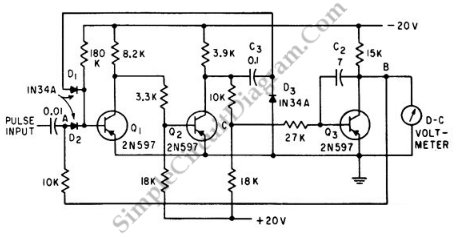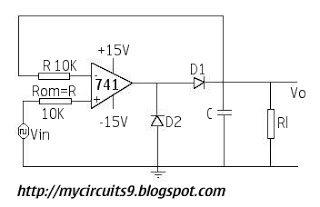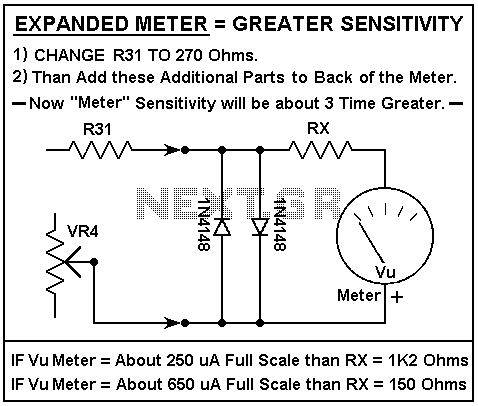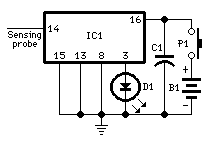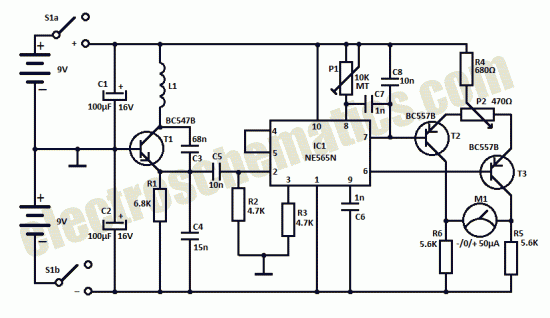
Peak detector II
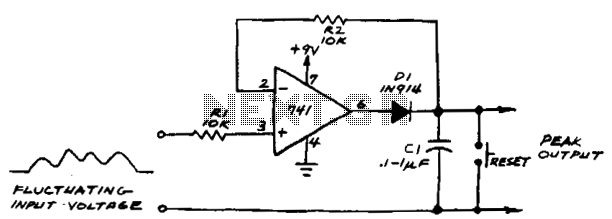
If the subsequent input voltage exceeds that stored in C1, the comparator voltage will go high and charge C1 to the new higher peak voltage. The comparator will charge C1 until the voltage across the capacitor equals the input voltage.
In this circuit, a comparator is utilized to monitor the voltage levels and control the charging of a capacitor, designated as C1. The operational principle hinges on the comparator's ability to compare the voltage across C1 with an incoming voltage signal. When the input voltage surpasses the voltage currently stored in C1, the comparator output transitions to a high state, indicating that the capacitor should be charged.
The charging process involves the comparator actively driving a control signal that connects C1 to a voltage source. This connection allows C1 to accumulate charge until the voltage across its terminals matches the level of the incoming input voltage. The charging mechanism is typically facilitated through a resistor-capacitor (RC) network, which helps regulate the rate at which C1 charges, ensuring that the voltage rise is smooth and controlled.
Once the voltage across C1 equals the input voltage, the comparator output will revert to a low state, effectively stopping the charging process. This behavior establishes a feedback loop that maintains the voltage across C1 at the same level as the input voltage, thus enabling stable operation in applications such as voltage regulation, peak detection, or signal conditioning.
The design considerations for this circuit should include the selection of appropriate values for C1 and any resistors used in conjunction with the comparator, as these components will influence the response time and stability of the circuit. Additionally, the comparator's specifications, such as its input voltage range and output drive capability, must be compatible with the intended application to ensure reliable performance. If subsequent input voltage exceeds that stored in Cl, the comparator voltage will go high and charge Cl to new higher peak voltage. The comparator will charge Cl until the voltage across the capacitor equals the input voltage. 🔗 External reference
In this circuit, a comparator is utilized to monitor the voltage levels and control the charging of a capacitor, designated as C1. The operational principle hinges on the comparator's ability to compare the voltage across C1 with an incoming voltage signal. When the input voltage surpasses the voltage currently stored in C1, the comparator output transitions to a high state, indicating that the capacitor should be charged.
The charging process involves the comparator actively driving a control signal that connects C1 to a voltage source. This connection allows C1 to accumulate charge until the voltage across its terminals matches the level of the incoming input voltage. The charging mechanism is typically facilitated through a resistor-capacitor (RC) network, which helps regulate the rate at which C1 charges, ensuring that the voltage rise is smooth and controlled.
Once the voltage across C1 equals the input voltage, the comparator output will revert to a low state, effectively stopping the charging process. This behavior establishes a feedback loop that maintains the voltage across C1 at the same level as the input voltage, thus enabling stable operation in applications such as voltage regulation, peak detection, or signal conditioning.
The design considerations for this circuit should include the selection of appropriate values for C1 and any resistors used in conjunction with the comparator, as these components will influence the response time and stability of the circuit. Additionally, the comparator's specifications, such as its input voltage range and output drive capability, must be compatible with the intended application to ensure reliable performance. If subsequent input voltage exceeds that stored in Cl, the comparator voltage will go high and charge Cl to new higher peak voltage. The comparator will charge Cl until the voltage across the capacitor equals the input voltage. 🔗 External reference
Warning: include(partials/cookie-banner.php): Failed to open stream: Permission denied in /var/www/html/nextgr/view-circuit.php on line 713
Warning: include(): Failed opening 'partials/cookie-banner.php' for inclusion (include_path='.:/usr/share/php') in /var/www/html/nextgr/view-circuit.php on line 713
